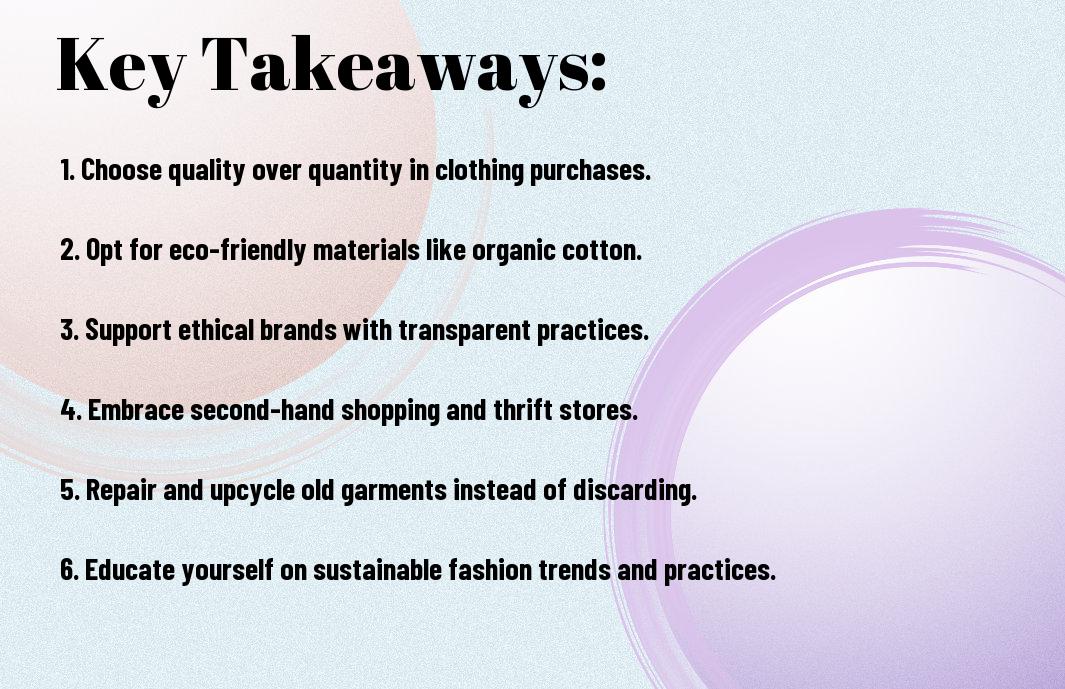As you navigate the world of fashion, you’re likely considering the impact of your clothing choices on the environment. Your purchasing decisions can significantly influence the sustainability of the fashion industry. You can make a positive change by adopting practices that reduce waste and support eco-friendly brands. By understanding your options and making informed decisions, you can cultivate a more sustainable approach to fashion, aligning your style with your values and contributing to a more environmentally conscious future.
Key Takeaways:
To make a positive impact on the environment through your clothing choices, consider the following points:
- Invest in high-quality and durable clothing that will last longer, reducing the need for frequent purchases and waste.
- Choose second-hand or vintage clothing as an alternative to buying new, which can help reduce the demand for resource-intensive new garments.
- Opt for clothing made from sustainable materials, such as organic cotton, recycled polyester, or Tencel, which have a lower environmental impact than traditional materials.
- Consider the end-of-life of your clothing and choose items that can be easily recycled or upcycled, reducing the amount of waste sent to landfills.
- Support transparent and accountable fashion brands that prioritize ethics and sustainability in their production processes, ensuring fair labor practices and minimal environmental harm.
Finding Sustainable Fashion
For those looking to make a positive impact on the environment, finding sustainable fashion is a great place to start. You can begin by exploring brands that prioritize eco-friendly materials and production methods, and considering the longevity of the pieces you purchase.
Knowing Your Fabrics
Upon examining your wardrobe, you’ll notice that different fabrics have varying effects on the environment. You can make informed choices by learning about the fabrics used in your clothing and opting for sustainable options that align with your values.
The Impact of Fast Fashion
Against the backdrop of growing environmental concerns, the impact of fast fashion cannot be ignored. You play a significant role in reducing waste and pollution by choosing to invest in sustainable fashion over fast, trendy pieces.
In fact, the production and distribution of fast fashion contribute significantly to greenhouse gas emissions, water pollution, and textile waste. As you become more mindful of your fashion choices, you’ll find that investing in sustainable fashion not only benefits the environment, but also promotes a more thoughtful and intentional approach to your personal style.

Buying Second-Hand
Now, you can make a significant impact on the environment by choosing second-hand clothing, reducing waste and supporting sustainable fashion. This approach helps to extend the life of existing garments, decreasing the demand for new, resource-intensive clothing.
Thrift Store Treasures
Thrifty shopping allows you to discover unique, high-quality pieces while reducing your environmental footprint. You can find one-of-a-kind items that reflect your personal style, often at affordable prices.
Online Marketplaces
Treasured online platforms offer a wide range of second-hand clothing, making it easy to find what you’re looking for from the comfort of your own home. You can browse through various sellers, filter by size, and read reviews to ensure a smooth transaction.
Due to the rise of online marketplaces, you have access to a vast array of second-hand clothing options, allowing you to shop sustainably and conveniently. You can explore different websites, apps, and social media platforms to find the perfect second-hand piece that fits your style and budget, making sustainable fashion more accessible than ever.
Quality Over Quantity
Unlike fast fashion, which prioritizes trendy pieces over durability, choosing quality over quantity is imperative for sustainable fashion. You can make a significant impact by investing in a smaller number of high-quality, long-lasting items that won’t need to be replaced often.
Investing in Timeless Pieces
The key to a sustainable wardrobe is investing in timeless pieces that won’t go out of style quickly. You should look for classic designs, high-quality materials, and attention to detail, as these factors will ensure your clothes last for years to come.
Caring for Your Clothes
Adeptly maintaining your clothes is vital to extending their lifespan. You can start by following the care labels, avoiding machine washing when possible, and making repairs instead of replacing items.
It is also important to consider the environmental impact of your laundry habits, as excessive washing and drying can lead to significant water and energy consumption. You can make a difference by washing your clothes in cold water, hanging them to dry, and avoiding fabric softeners and bleach, which can damage your clothes and harm the environment.

Fashionable Alternatives
Once again, you can make a difference by exploring alternatives to fast fashion, and you can start by checking out Top 10 Tips for Sustainable Fashion | Future.Green for more information.
Renting and Sharing
Beneath the surface of traditional fashion lies the option of renting and sharing, which allows you to wear stylish outfits without committing to a purchase, reducing your environmental footprint.
Swapping with Friends
Across various social circles, swapping clothes with friends has become a popular trend, enabling you to refresh your wardrobe without buying new, and you can try this approach with your friends.
Also, swapping with friends can help you discover new styles and pieces you may not have considered before, and you can use online platforms or host swapping events to make the process easier and more enjoyable, allowing you to connect with like-minded individuals who share your passion for sustainable fashion.
The Power of Choice
All your fashion choices have an impact on the environment and society. By making sustainable fashion choices, you can contribute to a more responsible industry.
Voting with Your Wallet
Allying your values with your purchases sends a message to the fashion industry. You decide what brands thrive based on your spending habits.
Supporting Eco-Friendly Brands
Around the world, brands are emerging with environmentally-friendly practices. You can support these brands by choosing their products over others.
Your decision to support eco-friendly brands can significantly influence the fashion industry’s shift towards sustainability. You will be promoting practices that reduce waste, use recycled materials, and implement fair labor conditions, ultimately contributing to a more environmentally conscious future for fashion.
Making a Difference
Many of your daily choices can contribute to a more sustainable fashion industry, and by making conscious decisions, you can have a significant impact. Your role in promoting sustainable fashion is vital, and every small action counts.
Small Steps to Big Change
Around every corner, you’ll find opportunities to make a positive impact, starting with your own wardrobe and shopping habits. You can begin by investing in high-quality, eco-friendly clothing and reducing your fast fashion purchases.
Inspiring Others
Beneath the surface of your personal sustainable fashion journey lies the potential to inspire those around you. You can share your knowledge and experiences with friends and family, encouraging them to make more informed choices.
Further, as you continue to make sustainable fashion choices, you’ll become a role model for others, demonstrating that stylish and responsible fashion is achievable. You can use social media platforms to showcase your favorite eco-friendly brands, share tips on sustainable fashion, and engage with like-minded individuals who share your passion for creating a more sustainable fashion industry.
Conclusion
With these considerations, you can make informed decisions about your fashion choices. You will be able to reduce your environmental impact by choosing sustainable materials, buying second-hand, and caring for your clothes properly. By incorporating these tips into your daily life, you will contribute to a more sustainable fashion industry and make a positive impact on the planet with your purchasing power, shaping your style while protecting the environment with your conscious choices.
FAQ
Q: What are some simple ways to make my wardrobe more sustainable?
A: To make your wardrobe more sustainable, consider investing in timeless pieces that won’t go out of style quickly, choose clothing made from eco-friendly materials like organic cotton, recycled polyester, or Tencel, and avoid fast fashion by buying second-hand or swapping clothes with friends. Additionally, learning to care for your clothes properly, such as washing them in cold water and hanging them to dry, can significantly extend their lifespan and reduce waste.
Q: How can I identify sustainable fashion brands and make informed purchasing decisions?
A: Identifying sustainable fashion brands involves looking beyond the surface level. Check if the brand has a clear sustainability policy on their website, which includes details about their supply chain, material sourcing, and waste management. Look for certifications like GOTS (Global Organic Textile Standard) for organic cotton products or Bluesign for environmentally friendly textile production. Moreover, reading reviews and articles from reputable sources can provide insights into a brand’s commitment to sustainability. It’s also important to question the brand directly through social media or customer service about their practices if the information is not readily available.
Q: What role does clothing rental or sharing play in sustainable fashion, and how can I get involved?
A: Clothing rental or sharing services are innovative ways to embrace sustainable fashion by reducing the need for new, resource-intensive clothing purchases. These platforms allow users to rent outfits for special occasions or subscribe to monthly boxes that offer a variety of clothing items. To get involved, start by researching local clothing rental services in your area or online platforms that cater to your style and needs. Some popular options include clothing swap events, online marketplaces for gently used clothing, and fashion subscription boxes that focus on sustainability. By participating in clothing rental or sharing, you not only reduce your environmental footprint but also have the opportunity to experiment with new styles without the long-term commitment of purchasing.


